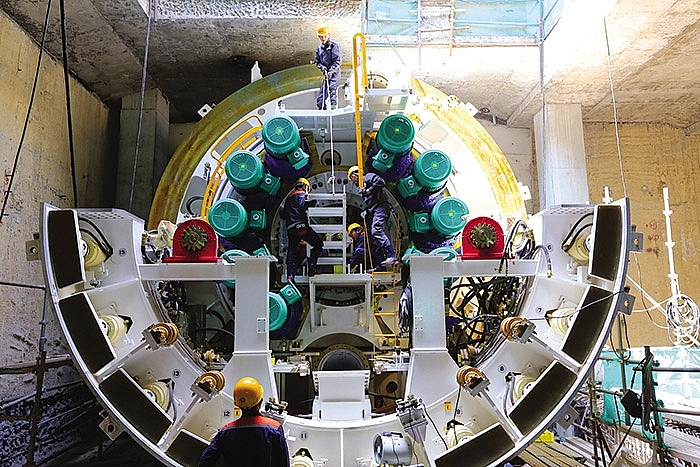Sustaining economic growth
 |
| Do Thien Anh Tuan, economist from Fulbright University Vietnam |
Achieving an economic growth raet of 7.08 per cent against the initial economic growth goal of 6.7 per cent is considered an impressive achievement of the Vietnamese government in macro-monitoring in 2018.
This attainment has been made possible thanks to the government’s great efforts. The prime minister and ministers have taken the initiative in issuing policies and directly meeting with localities, organisations, and the business community to encourage them to develop. They have also organised and attended meetings and dialogues at home and abroad in order to enhance the country’s image and position internationally, and to seek opportunities to develop the country.
Along with high growth, the quality has also improved. Credit growth for 2018 is estimated at about 15 per cent, lower than 17-18 per cent in the previous years. The contribution of the total factor productivity (TFP), which is a measure of efficiency of all inputs to a production process, to the economy’s 7.08 per cent growth this year is estimated to be 1.83 percentage points, far higher than in previous years.
The economy has continued keeping its stable pace, with inflation continued to be controlled at below 4 per cent, while the monetary and foreign currency market has seen no big fluctuation. This means that the growth has become more stable than in recent years.
Challenges remain
However, besides positive results, the economy still faces lots of difficulties, almost all of which have failed to be removed over the last few years. And new challenges have recently emerged.
Firstly, a rise of salaries higher than the improvement in labour productivity has posed a concern. Although warnings have been given about the gradual absence of abundant labour and low salaries, this still attracts investors into Vietnam.
The Vietnamese government cannot control the pay rise because the current average level remains lower than the living standards in the country. However, any pay rise must be conducted based on an increase in labour productivity. This means that increasing labour productivity is the most important, as it can help improving Vietnam’s competitive advantages when the country is boosting its participation in the EU-Vietnam Free Trade Agreement (EVFTA) and the Comprehensive and Progressive Agreement for Trans-Pacific Partnership (CPTPP).
Different from traditional FTAs, the reduction and removal of import tariffs have no longer been a focus of new-generation FTAs which, instead, centre into institutional reform, improving capacity in state governance, boosting equal competition, reducing transaction costs, and empowering people and fostering human capital. These factors will really create competitive advantages to the economy.
Secondly, financial reform has accelerated, helping improve the profits, capital, and asset quality of many banks thanks to high growth of the economy, and the government’s efforts in addressing bad debts.
However, some banks still face numerous risks such as high bad debts, low profits and weak equity. Some joint stock banks are scratching their heads over how to restructure themselves.
Thirdly, according to a government report, public debt reduced from 63.7 per cent of GDP in 2016 to 62.6 per cent in 2017, and will head to an estimated 61.4 per cent in 2018. In 2019, the rate is expected to be 61.3 per cent of GDP. Though the public debt remains in a stable trajectory, it is necessary to improve the fiscal situation in order to increase the capacity in responding to medium-term challenges.
Special attention needs to be paid to foreign debts, which sat at 45.2 per cent of GDP in 2017, and 49.7 per cent in 2018. It is expected that the rate will be 49.9 per cent of GDP in 2019, almost hitting the 50 per cent limit set by the National Assembly. According to the International Monetary Fund, the rate is expected to rise to 54 per cent of GDP by 2023.
The economy is estimated to see a trade surplus of 2.6 per cent of GDP in 2018. However, there has been a big difference in trade balance between foreign-invested enterprises (FIEs), which often enjoy a big trade surplus (about 12.75 per cent of GDP), and the domestic economic sector, which always suffers from a trade deficit (nearly 10.15 per cent of GDP).
 |
| Infrastructure development plays a pivotal role in helping the country take advantage of benefits from FTAs |
Heading into 2019
It is expected that the new year will follow 2018 with new opportunities and familiar challenges. The CPTPP and EVFTA will usher in great opportunities for Vietnamese people and business community thanks to reduced and removed tariffs. This will also help expand the economy’s medium-term growth, in addition to more drastic reform.
The growth momentum for the year will not be different from 2018, including improvement in domestic investment capital, along with foreign direct investment (FDI) inflows to the country because of trade frictions and Vietnam’s bright prospects; improvement in productivity and business climate; and a quick rise in the middle-class with big demand for consumption.
To boost this momentum, the government needs to implement three policy priorities for 2019. Firstly, it is necessary to continue maintaining the stable macroeconomic and socio-political climate, especially fiscal and monetary policies, and the private economic sector. This is aimed to increase the resilience and absorb positive impacts from the global economy.
The growth momentum for 2019 will continue being maintained even when the monetary policy will likely be tightened slightly and there will likely be a neutral fiscal policy. Overall, inflation will be kept at below 4 per cent, but sometimes will be pressurised by a rise in the world’s prices and in petrol prices, as well as some public services. The financial sector must continue being consolidated in 2019. Despite a gradual reduction in budget deficit, it remains at a high level. The banking sector is still pressurised by three factors including lending rate, exchange rate, and capital flows. Foreign currency reserves have continued increasing, but so as to control growth in money supply to rein in inflation, the central bank needs to interfere. This may affect lending rate and businesses’ production.
Secondly, it is necessary to boost institutional reform, including the reform of state-owned enterprises which needs to be sped up – with a focus laid on not only equitisation but also divestment, reduction of privilege in land and credit, among many other special advantages.
FDI will continue being considered a key player taking the lead in upgrading value chains, improving productivity and absorbing labour from the agricultural and informal sectors. The capacity in fostering linkages between domestic businesses and FIEs and their spill-over effects can filter through if Vietnam has a strong community of domestic businesses.
Thirdly, it is necessary to further boost startups and encourage innovations and renovations. More investment into human resources and high-quality infrastructure needs to be regarded as a policy priority, in order to improve productivity and upgrade the business climate. In this respect, the government needs to invest more into educational reform, especially university education with a focus laid on science, technology, engineering and mathematics. The government has set a growth target of 6.6-6.8 per cent for 2019. If the government remains consistent with its commitments in boosting reform and takes advantage of all opportunities and weather all challenges, the growth rate can hit 7 per cent.
What the stars mean:
★ Poor ★ ★ Promising ★★★ Good ★★★★ Very good ★★★★★ Exceptional
Related Contents
Latest News
More News
- Double-digit GDP growth within reach with shift to higher-value expansion (January 06, 2026 | 08:33)
- Ho Chi Minh City projects $10.5 billion remittance inflows in 2025 (December 31, 2025 | 18:58)
- Digital shift reshaping Vietnam’s real estate brokerages (December 31, 2025 | 18:54)
- New decree sharpens enforcement in securities market (December 31, 2025 | 18:53)
- Voluntary Sustainability Standards pave way for Vietnam’s agricultural exports (December 31, 2025 | 09:00)
- Gold market reform advances as SBV receives applications for bullion production (December 30, 2025 | 12:07)
- Textile apparel firms deliver robust earnings despite global tariff pressures (December 30, 2025 | 10:09)
- Ho Chi Minh City hits $8.37 billion in FDI (December 29, 2025 | 08:28)
- Tax sector wraps up 2025 and sets priorities for next year (December 25, 2025 | 14:00)
- Heavy industries set for pilot greenhouse gas quotas (December 25, 2025 | 10:00)

 Tag:
Tag:




















 Mobile Version
Mobile Version